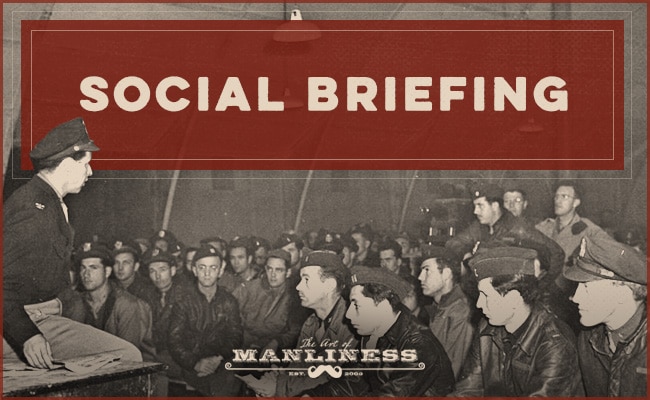
Social Briefings are short bi-monthly dispatches that offer practical tips to improve your social skills. Read more on their raison d’etre.
So you know how to approach people to initiate a conversation, and how to make it more likely that folks will approach you to chat.
But once you’re “in†what then? How do you actually begin engaging in small talk and how do you build the conversation from there?
Communications expert Dr. Carol Fleming has formulated what is arguably the easiest and most effective method for initiating small talk: a three-part process that moves from Anchor, to Reveal, to Encourage (“AREâ€).
Let’s unpack what’s involved with each step:
Anchor
Kick off a conversation by anchoring it in your “mutual shared reality.†Your opening line extends the first little thread of connection between you and another person — the lightest of pleasantries about something you’re both seeing or experiencing. You can talk about what’s going on around you — the weather, atmosphere, environment, food, happenings of the situation you’re in — or compliment the person you’re engaging.
- Packing up things after class: “Those exam questions were way different than I was expecting.”
- Passing by each other in the weight room: “Great lift!”
- Standing in line for food at a wedding: “Pie for a wedding dessert! I’ve never seen that before, but it’s awesome.”
Don’t get caught up thinking that such comments are too superficial, and search in vain for something truly clever to say. Fleming calls such exchanges “friendly noises,†and you both know they’re not meaningful, but just a gradual and polite way to segue into a “real†conversation.
Reveal
Next, disclose something about yourself that is related to the anchor you just threw out:
- “I decided to study for the first time this semester, but I guess I studied all the wrong things!”
- “I’d love to be able to pull that much weight on the deadlift.”
- “Can’t say I’ve ever been a big fan of wedding cake anyway.”
By opening up a little more, we extend to the other person a few more threads of connection and trust, while at the same time providing them fodder to which to respond.
Encourage
Now you hand off the ball to them by asking a question:
- “Did the test surprise you too?”
- “Are you following a specific program?”
- “Are you [a fan of wedding cake]?”
Keep Building the Conversation
By employing the effective ARE method, you’ll successfully have exchanged a few pleasantries, but these tender threads of small talk can still easily disintegrate and blow away at this point.
So you want to weave those light threads into an increasingly sturdy rope. You do this by offering follow-up comments and questions designed to elicit responses that will continue to build the conversation. Giving a comment takes more skill, as you have to craft one that will continue the back and forth. Ideally, you should form both a comment and a back-up question in your mind so that if they respond to your comment with only a laugh or an uh-huh, you’re ready to get things moving again.
Let’s take a look at how our three example conversations might progress:
You: “Those exam questions were way different than I was expecting. I decided to study for the first time this semester, and I guess I studied all the wrong things! Did the test surprise you too?”
Other Person: “Definitely. I really focused all my studying on the Civil War period and there wasn’t a single question about that!”
You: “I think I’m going to need to take advantage of the extra credit opportunity by going to one of the museums here in town. Do you have any recommendations on which is the best?”
You: “Great lift — I’d love to be able to pull that much weight on the deadlift. Are you following a specific program?”
Other Person: “Have you heard of Starting Strength?”
You: “No, I haven’t. Is it something that real beginners can do?”
You: “Pie for a wedding dessert! I’ve never seen that before, but it’s awesome. Can’t say I’ve ever been a big fan of wedding cake anyway. Are you?”
Other Person: “Nah, it’s always dry.”
You: “Exactly! I was once at wedding that just had a huge table of cookies and big glasses of milk and I thought that was a great idea too.”
Other Person: “Yeah, that would be great.”
You: “So how do you know the happy couple?”
Whether you follow-up with a comment or question, be sure to alternate between the two options and strike a balance: too many questions fired one right after the other will make the conversation feel more like an interrogation, and too many of your own comments won’t give the other person a chance to talk. That’s no good, as your interest in what they have to say is what endears you to them.
So tip the scale more heavily towards questions, especially of the open-ended variety. How do you craft open vs. closed questions? That’s what we’ll discuss next time.


